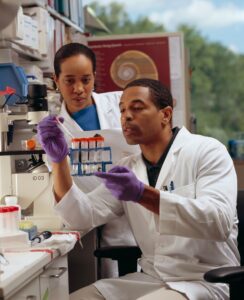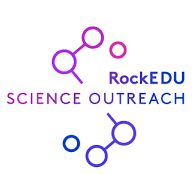Diversity, Equity & Inclusion
 It has required the knowledge of people from all cultures and genders across the globe to realize some of the world’s most important scientific advances, from breakthroughs in particle physics to landing the first person on the moon. In fact, studies have shown that diverse research teams create more rigorous and effective science. A diverse and inclusive STEM community also improves communications and engagement with underrepresented communities and shows future scientists of diverse backgrounds they have a home in STEM.
It has required the knowledge of people from all cultures and genders across the globe to realize some of the world’s most important scientific advances, from breakthroughs in particle physics to landing the first person on the moon. In fact, studies have shown that diverse research teams create more rigorous and effective science. A diverse and inclusive STEM community also improves communications and engagement with underrepresented communities and shows future scientists of diverse backgrounds they have a home in STEM.
The work to diversify the STEM community is critical to the success and future of science, and it is an effort that all scientists should embrace advancing. Here we provide resources to help you reach more diverse audiences, amplify diverse voices, communicate inclusively, and promote creation of a STEM community focused on diversity, equity and inclusion.
Diverse Voices
Sharing and highlighting the stories and work of scientists from diverse backgrounds can encourage greater participation and trust in the STEM community. These resources can help:
- ScienceMakers Digital Archive and Untold Stories have archives cataloguing the stories and contributions of current and past scientists of diverse race, gender and cultural backgrounds.
- 500 Women Scientists developed Gage, a database tool for journalists, educators and others to find women and gender minorities STEM professionals.
- The “Science Diversified” collection from the Nature Careers Podcast series highlights the experiences and voices of scientists from diverse backgrounds.
Inclusive STEM Outreach
These organizations offer resources and tips for developing inclusive science communications skills for a variety of audiences from kids to adults.
- RockEDU Inclusive Outreach has a variety of helpful resources for promoting inclusive science, including a mentoring handbook and case studies.
- Created by BioBus interns during the summer of 2020 in the midst of protests against police brutality and the disproportionate effects of the COVID-19 pandemic on Black and Brown communities, “Resources for Understanding Race, Advocacy and Managing Race-related Stress” is a guide aimed at helping the science community promote an understanding of racism and access resources for managing race-related stress.
 STEMTeachersNYC’s Culturally Responsive STEM Initiative offers workshops, resources and programs for kids and teens that you can get involved with to help promote and realize a more inclusive and diverse future for the STEM community.
STEMTeachersNYC’s Culturally Responsive STEM Initiative offers workshops, resources and programs for kids and teens that you can get involved with to help promote and realize a more inclusive and diverse future for the STEM community.- This podcast episode on building communication strategies for diversity and inclusion does a great job on describing how to craft stories and multimedia experiences that disrupt bias and drive social change.
Communicating Across Cultures & Languages
The ability to translate your science to other languages—spoken and signified—is an important step toward making STEM more inclusive.

- Kapwing offers a free resource for generating video captions in other languages.Here also is a video demonstrating how to do it.
- Check out this Nature article for tips on how to do science outreach in different languages.
- Zubtitle offers free video captioning—an important tool for engaging with hearing-impaired communities.
Building a STEM Community Focused on DEI
Connecting with professional organizations that support scientists from underrepresented communities and promote interaction between scientists from different cultures and disciplines can help you build an inclusive STEM community. Here are a few resources
 The MiSTEM network has collected data and resources that can help you understand and communicate workforce trends that underscore the critical need to diversify and make the STEM community inclusive.
The MiSTEM network has collected data and resources that can help you understand and communicate workforce trends that underscore the critical need to diversify and make the STEM community inclusive.- The Center for Advancement of Informal Science Education (CAISE) recently published a toolkit for ‘Broadening Perspectives on Broadening Participation in STEM.’ The toolkit includes documents like the full report, summaries for different stakeholders and conversation guides.
- The following organizations have put together lists of STEM organizations serving scientists from underrepresented communities:
- This Science magazine blog reviews a book that provides helpful tips that can help you advocate for greater diversity STEM in higher ed.

- AAAS has a variety of initiatives to help scientists advance diversity, equity and inclusion. They also host a Science, Ethics & Religion program, which aims to facilitate dialogue between scientific and religious communities.
- Medium blogger Priya Shukla’s reading list can help you understand the experiences of scientists from other backgrounds and develop a framework for communicating about STEM diversity, equity and inclusion.
- Also check out this article describing the current landscape of inclusive SciComm, summarizing a 2020 report that emphasizes the need for intentionality, reciprocity and reflexivity.
- The World Economic Forum offers tips for supporting STEM diversity that can be incorporated into your messaging.
Ways to Get Involved
These organizations and ongoing efforts offer ways for you to use your voice to promote diversity in STEM.
- Role Models Matter, an initiative run by TechBridge Girls, has an online Training Toolkit to help you develop skills to engage girls and underrepresented youth in STEM.
- The New York Academy of Sciences has a number of inclusive STEM outreach programs, such as 1000 Girls, 1000 Futures and the Junior Academy.
- The Inclusive SciComm Symposium is “a biennial international convening of practitioners, trainers, researchers, educators, funders, and others who work across diverse disciplines and settings to prioritize inclusion, equity, and intersectionality in all forms of science communication.”
 It has required the knowledge of people from all cultures and genders across the globe to realize some of the world’s most important scientific advances, from breakthroughs in particle physics to landing the first person on the moon. In fact, studies have shown that diverse research teams create more rigorous and effective science. A diverse and inclusive STEM community also improves communications and engagement with underrepresented communities and shows future scientists of diverse backgrounds they have a home in STEM.
It has required the knowledge of people from all cultures and genders across the globe to realize some of the world’s most important scientific advances, from breakthroughs in particle physics to landing the first person on the moon. In fact, studies have shown that diverse research teams create more rigorous and effective science. A diverse and inclusive STEM community also improves communications and engagement with underrepresented communities and shows future scientists of diverse backgrounds they have a home in STEM.

 STEMTeachersNYC’s
STEMTeachersNYC’s 
 The
The 

